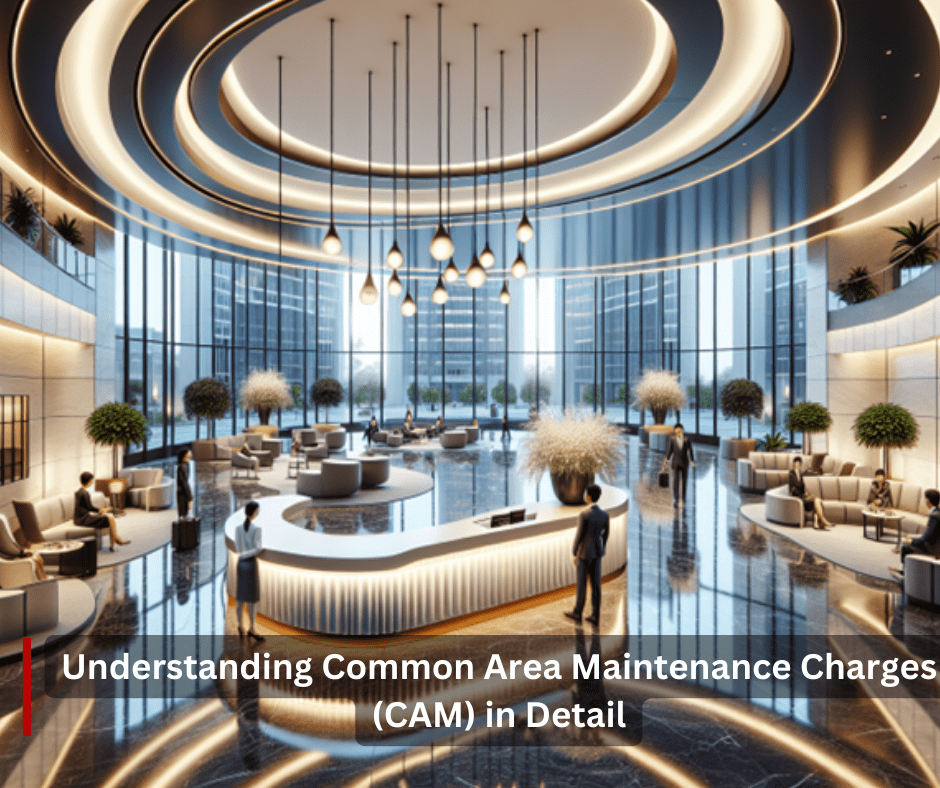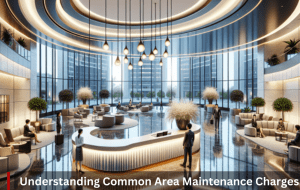
Understanding Common Area Maintenance Charges (CAM) in Detail
Published At: Mon, 07/29/2024 - 12:22
When you're involved in commercial real estate, understanding common area maintenance charges is crucial. These fees, often referred to as CAM charges, play a significant role in the overall cost of leasing commercial property. They cover expenses related to maintaining and operating shared spaces within a building or complex, impacting both landlords and tenants alike.
In this article, you'll learn about the components that make up CAM charges, including utilities, property taxes, insurance, and janitorial services. We'll break down how these fees are calculated and allocated among tenants, typically as part of a triple net lease agreement. You'll also gain insights into the importance of common areas in commercial properties and how CAM fees relate to base rent. By the end, you'll have a clearer picture of what to expect when dealing with common area maintenance in commercial real estate.
What are Common Area Maintenance (CAM) Charges?
Definition of CAM charges
Common Area Maintenance (CAM) charges are fees you pay as a tenant in addition to your base rent in a commercial lease. These charges cover the expenses related to maintaining and operating shared spaces within a commercial property or complex. CAM fees typically include costs for areas that all tenants use or benefit from, such as lobbies, elevators, parking lots, hallways, public bathrooms, and shared facilities like fitness centers.
The exact scope of CAM charges can vary greatly between individual lease agreements. Landlords often try to negotiate for a broader interpretation of CAM fees to reduce their risk exposure, while tenants usually aim to narrow the interpretation to lower their monthly expenses.
Purpose of CAM charges
The primary purpose of CAM charges is to allow landlords to recover the costs associated with managing and maintaining the common areas of a commercial property. By passing these expenses on to tenants, property owners can protect themselves from fluctuations in maintenance costs and ensure a stable return on investment.
For tenants, CAM charges serve several purposes:
- Ensuring well-maintained common areas: When landlords can pass on maintenance costs, they're more likely to keep up with repairs and upkeep, resulting in cleaner, better-maintained spaces for tenants.
- Sharing responsibility: CAM charges distribute the costs of maintaining shared spaces among all tenants who benefit from them.
- Transparency: These charges provide a breakdown of the expenses related to operating the property, giving tenants insight into where their money is going beyond base rent.
Types of properties that typically have CAM charges
CAM charges are common in various types of commercial properties, but their prevalence and structure can differ depending on the property type:
- Retail space: CAM charges are very common in retail properties, often including expenses for parking lot maintenance, common area lighting, and landscaping.
- Office buildings: While some office leases include CAM charges as separate fees, others may incorporate them into the base rent.
- Industrial properties: Warehouses and other industrial spaces typically have CAM charges, though they may be more limited in scope compared to retail or office properties.
- Mixed-use developments: These properties often have complex CAM structures due to the variety of tenants and shared spaces.
It's important to note that the specific items included in CAM charges can vary significantly based on the property type and individual lease agreement. For example:
- Office properties might include charges for elevator maintenance, lobby upkeep, and shared conference rooms.
- Industrial properties often focus on parking lot maintenance, exterior lighting, and landscaping.
- Retail spaces may include marketing expenses for the property as a whole in their CAM charges.
Understanding the typical CAM charges for your property type can help you negotiate more effectively and budget accurately for your commercial lease.
Components of CAM Charges
Typical expenses included in CAM
Common Area Maintenance (CAM) charges encompass a wide range of expenses associated with maintaining and operating shared spaces in commercial properties. As a tenant, you can expect to see the following typical expenses included in your CAM charges:
- Property Management: This includes costs related to property management services, such as salaries, administrative costs, and management fees.
- Utilities: Expenses for common area utilities like electricity, water, gas, and sewer are often part of CAM charges. In office buildings, electricity is typically metered across the entire building and included in CAM expenses.
- Landscaping and Grounds Maintenance: Costs for maintaining outdoor spaces, including lawn care, tree trimming, and landscaping, are usually included.
- Janitorial Services: Expenses for cleaning and maintaining common areas like hallways, restrooms, and lobbies are part of CAM charges, especially in office properties.
- Repairs and Maintenance: This covers the cost of repairing and maintaining common elements, including HVAC systems, elevators, parking lots, and structural repairs.
- Security: Costs associated with security services and systems that protect the property and its tenants are often included.
- Insurance: Common area insurance, which covers liability and property insurance for shared spaces, is typically part of CAM charges.
- Taxes: Some leases include property tax expenses as part of CAM charges.
- Snow Removal: In applicable climates, snow removal services are often included in CAM expenses.
- Parking Lot Maintenance: This includes costs for maintaining, repairing, and sometimes resurfacing parking areas.
Expenses that may be excluded from CAM
While CAM charges cover many aspects of property maintenance, certain expenses are often excluded or negotiated separately:
- Capital Expenditures: In most cases, capital improvements are typically part of a landlord's cost of ownership and are not included in CAM charges. However, there are exceptions when these expenditures directly reduce a tenant's CAM charges.
- Structural Repairs: Major structural repairs are often the responsibility of the landlord and may not be included in CAM charges, especially in triple net (NNN) leases.
- Tenant-Specific Utilities: In retail and industrial properties, electricity is often sub-metered, with tenants paying for their own usage separately from CAM charges.
- Individual Janitorial Services: In retail and industrial properties, tenants often contract their own janitorial services for their specific spaces.
Variations in CAM charges by property type
CAM charges can vary significantly depending on the type of commercial property:
Office Properties:
- Often include electricity costs in CAM charges
- Janitorial costs for common areas are typically included
- May have higher CAM charges due to more extensive common areas
Retail Properties:
- Electricity is usually sub-metered and paid separately by tenants
- Less common space means janitorial costs are often excluded from CAM
- May include maintenance fees for sidewalks, driveways, and loading docks
Industrial Properties:
- Electricity is typically sub-metered and paid separately by tenants
- Janitorial services are often individually contracted by tenants
- CAM expenses usually focus on property and parking lot lighting, landscaping, and water for irrigation
It's important to note that the specific components of CAM charges can vary greatly between individual lease agreements. Landlords often try to negotiate for a broader interpretation of CAM fees, while tenants typically aim to narrow the interpretation to lower their monthly expenses. As a tenant, you should carefully review your lease agreement to understand exactly what is included in your CAM charges and consider seeking expert advice to fully comprehend how these charges will affect your business in the long term.
How CAM Charges are Calculated
Pro-rata share calculation
To calculate your share of Common Area Maintenance (CAM) charges, landlords typically use a pro-rata share method. This approach determines your responsibility based on the amount of space you occupy in the building. The calculation is straightforward:
- Determine your leased square footage
- Identify the building's total square footage (defined area)
- Divide your leased space by the defined area
- Multiply the result by 100 to get your pro-rata share percentage
For example, if you lease 1,250 square feet in a 25,000 square foot building, your pro-rata share would be 5% (1,250 / 25,000 = 0.05 or 5%).
It's important to note that the defined area can be calculated in two ways:
- Gross Leasable Area (GLA): Total square footage available for rent
- Gross Lease Occupied Area (GLOA): Total square footage of occupied space
As a tenant, the GLA method is generally more advantageous because it spreads expenses across all leasable space, potentially lowering your share of costs.
Estimating annual CAM expenses
Landlords estimate annual CAM charges at the beginning of each year. This estimate forms the basis for your monthly CAM payments. To create these estimates, landlords typically:
- Review utility bills from previous years
- Obtain quotes from contractors for services like landscaping, security, and maintenance
- Factor in potential increases due to inflation or unforeseen repairs
For new properties without historical data, landlords may:
- Contact utility companies for bill estimates
- Request on-site estimates from key contractors
- Add a buffer to account for unexpected costs
It's worth noting that landlords often slightly overestimate CAM charges to avoid significant year-end adjustments.
Year-end reconciliation process
At the end of each year, landlords perform a CAM reconciliation to compare actual expenses with the estimates you've been paying. This process ensures you pay only for the expenses incurred. Here's how it works:
- Landlords total up the actual CAM costs for the year
- They compare this total to the amount collected from tenants
- If you've overpaid, you may receive a refund or credit
- If you've underpaid, you'll need to pay the difference
The reconciliation process begins when you receive the year-end statement. It's crucial to review this statement carefully and verify that all charges align with your lease agreement. Some leases include caps on CAM increases or exclude certain expenses, so understanding your lease terms is essential.
Remember, changes in your leased space or the building's overall occupancy can affect your pro-rata share and, consequently, your CAM charges. Always stay informed about any changes in the property's occupancy or your lease terms to avoid unexpected costs.
Conclusion
Understanding Common Area Maintenance charges has a significant impact on how tenants approach commercial leases. These fees play a crucial role in maintaining shared spaces, ensuring a well-kept environment for all occupants. By grasping the components of CAM charges, their calculation methods, and the reconciliation process, tenants can better predict costs and negotiate more effectively with landlords.
Ultimately, CAM charges are an essential aspect of commercial real estate that requires careful consideration and ongoing attention. To get a deeper understanding of how these charges might affect your specific situation, it's always a good idea to seek expert advice. For personalized guidance on CAM charges and other commercial real estate matters, you can reach out to our team at (888) 518-9168. Remember, staying informed about your lease terms and property changes is key to managing your CAM expenses effectively and avoiding unexpected costs down the line.


